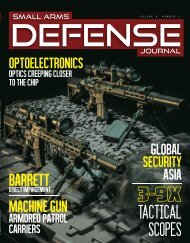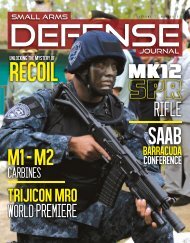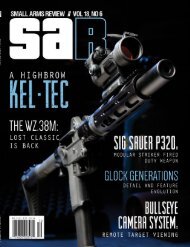You also want an ePaper? Increase the reach of your titles
YUMPU automatically turns print PDFs into web optimized ePapers that Google loves.
performance of the Mini MPIM. In detonation,<br />
M-MPIM sends out 315 spherical<br />
steel fragments with a muzzle velocity of<br />
2,300 meters per second in a repeatable<br />
fragmentation pattern. The M-MPIM has<br />
been optimized for a 20 meter wide – 2<br />
meter high “impact zone” at a distance of<br />
30 meters based on the distribution pattern<br />
that ensures 5-7 “hits” per square<br />
meter. The steel or tungsten projectiles<br />
remain effective to more than 100 meters<br />
against a man target. As with the DFC,<br />
this defined fragmentation pattern greatly<br />
increases operator safety and operational<br />
effectiveness. All lethal MPIMS have a<br />
rearward safety zone of 7m, based on concussive<br />
effects. This in itself is a dramatic<br />
change compared to the legacy system. An<br />
excerpt from the Army Field Manual (FM<br />
23-23) that applies to the M18A1 states:<br />
“Danger Area of Backblast and Secondary<br />
Missiles. Within an area of 16 meters<br />
to the rear and sides of the mine, backblast<br />
can cause injury by concussion (ruptured<br />
eardrums) and create a secondary missile<br />
hazard. Friendly troops are prohibited to<br />
the rear and sides of the mine within a radius<br />
of 16 meters. The minimum safe operating<br />
distance from the mine is 16 meters.<br />
At this distance, and regardless of how the<br />
mine is employed, the operator should be<br />
in a foxhole, behind cover, or lying prone<br />
in a depression. The operator and all<br />
friendly troops within 100 meters of the<br />
mine must take cover to prevent being injured<br />
by flying secondary objects such as<br />
sticks, stones, and pebbles.”<br />
Warfare Experiment (AEWE) Spiral J<br />
Live Fire where soldiers and marines present<br />
witnessed the effects from an “open”<br />
(unobstructed) distance “significantly<br />
less” than they would for the legacy device.<br />
The M-MPIM’s repeatable fragmentation<br />
pattern significantly reduces the possibility<br />
of collateral damage. Using the existing<br />
aiming device on the device proved highly<br />
effective during the AEWE demonstrations<br />
and there are discussions ongoing<br />
about incorporating a miniature laser aiming<br />
device that shows the impact zone. The<br />
Mini MPIM was granted a “Safety Release”<br />
(SR) by the Army Test and Evaluation<br />
Command for the AEWE live fire event.<br />
All lethal variants of the MPIM are the<br />
only Insensitive Munition (IM) compliant<br />
fragmentation charges available today.<br />
The M-MPIM is a basic device that stands<br />
ready to incorporate whatever accessories<br />
the war-fighter should desire, from stands<br />
to mounts to male-female attachment<br />
points for linking multiple devices together.<br />
A comparison of the Mini-MPIM vs the<br />
legacy system is below.<br />
TECHNICAL<br />
M-MPIMS<br />
M18A1<br />
SPECIFICATION<br />
Gross weight 1.9 lb 0.9 kg 3.5 lb 1.6 kg<br />
Net Explosive Quantity 1.1 lb 500 grams 1.5 lb 680 grams<br />
Width 4.2 in 106 mm 8.5 in 216 mm<br />
Height 3.3 in 83 mm 4.9 in 124 mm<br />
Depth 2.0 in 50 mm 1.5 in 38 mm<br />
Amount of fragments 315 315 700 700<br />
Fragment type Steel, round Steel, round Steel, round Steel, round<br />
Fragment diameter 13/64 5 mm 1/8 in 3 mm<br />
Fragment weight 0.02 oz 0.5 grams 0.015 oz 0.3 grams<br />
OPERATIONAL SPECIFICATION M-MPIMS M18A1<br />
CONCLUSION<br />
Effective range Over 50 m 50 m<br />
Penetration 2mm steel 40 m 35 m<br />
Muzzle velocity 2,300 m/s 1,200 m/s<br />
Fragment distribution equal un-equal<br />
Rear safety area 7 m 16 m<br />
Lifecycle 25 years No info<br />
Operational Climate Categories B3-C2 (-46°C to +71°C or -51°F to + 160°F) No info<br />
Hazard Classification 1.1D (1.2S and 1.2.3D upcoming) 1.1D<br />
Insensitive Munitions compliant YES NO<br />
The Multi-Purpose Infantry Munition<br />
System family gives the United States<br />
Military (and other foreign militaries) the<br />
capability to train and engage with an escalation<br />
of force needed at a specific time,<br />
in both offensive and defensive scenarios.<br />
The SQD/PLT trainer provides a realistic<br />
training device that replicates the MPIMs<br />
in every way. The MPIMS Force on Force<br />
Trainer (FOFT) provides a force on force<br />
training capability that until today, has<br />
not existed in the Military Training Centers.<br />
The Less Lethal and Non- Lethal<br />
MPIMs versions will provide a scalable,<br />
selectable, “plug and play” capability that<br />
can be tailored based on war-fighter requirements.<br />
Finally, the lethal versions<br />
provide a vast array of options, from large<br />
DFC with Tungsten or stainless steel<br />
ball bearings, to the Mini MPIM, that<br />
provide state of the art technology and<br />
unprecedented performance.<br />
MPIMS<br />
Mini-MPIM showing size relative to hand.<br />
SADEFENSEJOURNAL.COM 69









